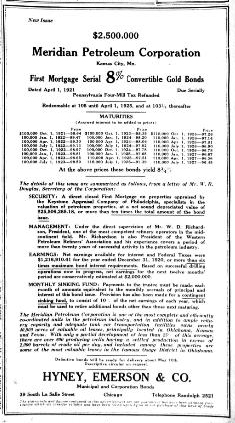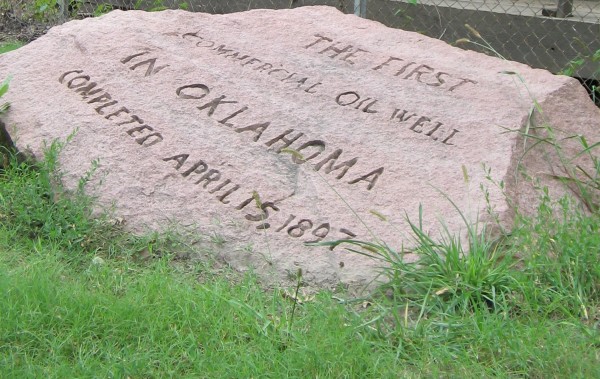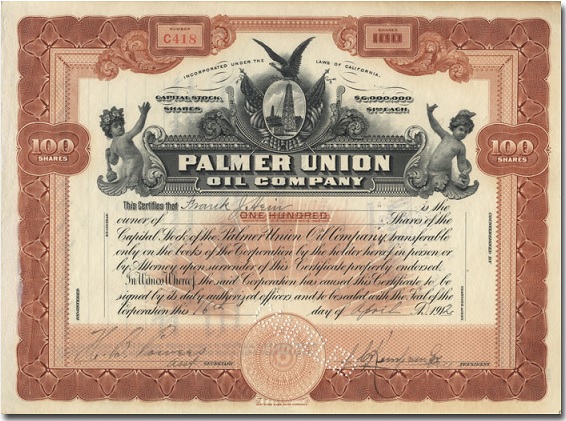by Bruce Wells | Feb 1, 2024 | Petroleum Companies
An experienced independent oil producer, W.D. Richardson orchestrated the merger of his own company, Lake Park Refining (incorporated 1918), with Dunn Petroleum and Davenport Petroleum to form Meridian Petroleum Company in September 1920.
Merger terms dictated one share of Dunn Petroleum for two shares Meridian Petroleum; one share of Lake Park Refining for two shares Meridian Petroleum; and one share of Davenport Petroleum Co. for 20 shares Meridian Petroleum.
 The combined organization held assets valued at about $13 million, including refineries in Oklahoma: Okmulgee (3,500 barrel), Ponca City (2,500 barrel), and Hominy (1,500 barrel). There also were producing wells in Oklahoma, Kansas and Texas, as well as “promising acreage” in Wyoming.
The combined organization held assets valued at about $13 million, including refineries in Oklahoma: Okmulgee (3,500 barrel), Ponca City (2,500 barrel), and Hominy (1,500 barrel). There also were producing wells in Oklahoma, Kansas and Texas, as well as “promising acreage” in Wyoming.

With offices in Kansas City, Missouri, Delaware-chartered Meridian Petroleum was capitalized at $25 million. By the end of 1920, the new company reported a net profit of $1,076,828. At the company’s annual meeting in April 1921, at least 3,000 Meridian Petroleum stockholders re-elected W.D. Richardson and the company’s officers.
“Rarely have stockholders made so plain their confidence in the management of an oil company,” noted The Oil & Gas News reported. At the same meeting, stockholders approved the issue of $2.5 million dollars in “first mortgage bonds to be used in retiring present outstanding indebtedness and to give the company additional working capital.”
Trade publications carried advertisements for Meridian Petroleum products such as “No. 1100 Straight Run Auto Oil” and “No. 22-600 S. R. Cylinder Stock (Light Green).” These and other lubricants were promoted with the Meridian motto, “The Line that Circles the World.”
But all was not well. The Oklahoma refineries depended upon crude oil deliveries, which were declining. Throughout 1921, only one of Meridian’s Petroleum’s three refineries operated at all, and it at half capacity.

The first official Oklahoma oil well was completed in 1897 at Bartlesville. Photo by Bruce Wells.
Oil production from Meridian Petroleum’s own leases proved insufficient, although in July 1921, Oildom reported a hopeful development.
“The company’s big well in the Hominy district of Osage county, Oklahoma, which came in at 10,000 barrels and ceased flowing after several days, due to a caved hole, was put in commission again and was reported making 3,000 barrels natural (flow),” the publication noted.
A report in the American Investor valued the company’s stock at about 13 cents a share on the New York Curb Market in December 1921, down from a high of 22 cents a share for the year and far less than the original offering at $2 per share.

On April 1, 1922, Meridian Petroleum defaulted on a $100,000 debt and in June, U.S. District Court appointed a receiver as the $2.5 million mortgage approved by stockholders a year earlier went into foreclosure. The company also carried unsecured debt of $600,000 and never paid a dividend.
Despite predictions of a reorganization, by 1927 Meridian Petroleum was gone for good. W.D. Richardson quickly went on to form the Richardson Refining Company, capitalized at $250,000 in November 1922.
The stories of exploration and production companies joining petroleum booms (and avoiding busts) can be found updated in Is my Old Oil Stock worth Anything? The Library of Congress offers further research help at Business History: A Resource Guide.
_______________________
Recommended Reading: The Prize: The Epic Quest for Oil, Money & Power (1991). Your Amazon purchase benefits the American Oil & Gas Historical Society. As an Amazon Associate, AOGHS earns a commission from qualifying purchases.
_______________________
The American Oil & Gas Historical Society (AOGHS) preserves U.S. petroleum history. Become an AOGHS annual supporting member and help maintain this energy education website and expand historical research. For more information, contact bawells@aoghs.org. Copyright © 2024 Bruce A. Wells. All rights reserved.
Citation Information – Article Title: “Meridian Petroleum Company.” Authors: B.A. Wells and K.L. Wells. Website Name: American Oil & Gas Historical Society. URL: https://aoghs.org/old-oil-stocks/meridian-petroleum-company. Last Updated: February 14, 2024. Original Published Date: January 29, 2016.
by Bruce Wells | Dec 4, 2023 | Petroleum Companies
Oilfield discovery in 1908 at Cat Canyon, California, began company’s lengthy corporate convolution.
In the Solomon Hills of central Santa Barbara County, California, the search for oil and natural gas began in 1904 at Cat Canyon. Exploration companies unsuccessfully drilled there for four years before Palmer Oil Company discovered an oilfield about 10 miles southeast of Santa Maria.

Palmer Oil Company derricks and refinery in Santa Barbara County, California, circa 1920s.
Palmer Oil’s Santa Maria well initially produced 150 barrels of oil a day, but within a few months it jumped to 10,000 barrels a day. The company completed a second well that also proved to be a true gusher. With it and other 1908 discoveries, Palmer Oil opened the Cat Canyon oilfield — the largest in Santa Barbara County at the time.

“The Palmer Oil Company is generally concluded to have opened one of the biggest and richest oil fields in California by the bringing in of its two gushers in the Cat Canyon District, now doing 10,000 barrels per day between them,” declared the trade publication “Oil Age Weekly” on September 9, 1910.
Although the Cat Canyon oilfield produced “heavy oil” with a high sulfur content, the success of Palmer Oil brought new investors, and the company was capitalized at $10 million by the beginning of 1911. The latest oil boom (see First California Oil Wells) attracted 26 exploration companies that completed 35 producing wells.

By 1927, Palmer Oil Company had reorganized into Palmer Union Oil Company as it continued to drill on Santa Barbara, California, leases.
By 1927, despite Cat Canyon’s proven oil reserves, drilling and production challenges of the heavy, high sulfur content prompted investors to look for better returns on their investments.
Palmer Oil to Coca-Cola
New drilling in Cat Canyon stalled — as did Palmer Oil, which began the first of its many corporate convolutions by becoming the Palmer Union Oil Company.
In January 1932, Palmer Union Oil became Palmer Stendel Oil Corporation, beginning decades of mergers and acquisitions: Palmer Stendel Oil Company – Petrocarbon Chemicals Incorporated – Great Western Producers – Pleasant Valley Wine Company – Taylor Wine Company – Coca-Cola Company.
After the Great Depression and World War II, water-flooding technology resurrected the Cat Canyon field’s production capability to a peak in 1953. Millions of barrels of oil were recovered and even in 1983, production was still about 350 barrels a day.

One century after its discovery by Palmer Oil Company, the Cat Canyon oilfield had 243 active oil wells. In a state long known for its natural oil seeps, enhanced recovery technologies revived oil production in Santa Barbara County and California’s other heavy oil-producing regions.
To extract reserves previously considered unrecoverable, companies like HVI Cat Canyon (Greka Energy), ERG Resources, and others used tertiary thermal recovery techniques. Improved technologies have dramatically lessened dangers to the environment, but not eliminated them.

A 1927 Palmer Union Oil Company stock certificate purchased at a garage sale in 2008 sparked a legal battle with Coca-Cola.
In 2023, a U.S. District Court found HVI Cat Canyon Inc. (formerly Greka Oil & Gas Company) liable for oil spills and ordered the company to pay $40 million in civil penalties for the spills; $15 million for violations of federal regulations, and $2.5 million in cleanup costs.
The U. S. Energy Information Administration in 2013 ranked Cat Canyon as 17th on its list of the nation’s top 100 producing oilfields — with no company having partial ownership in Coca-Cola Company (see Not a Millionaire from Old Oil Stock).
_______________________
The American Oil & Gas Historical Society (AOGHS) preserves U.S. petroleum history. Become an AOGHS annual supporting member and help maintain this energy education website and expand historical research. For more information, contact bawells@aoghs.org. Copyright © 2023 Bruce A. Wells. All rights reserved.
Citation Information – Article Title: “Palmer Oil Company.” Authors: B.A. Wells and K.L. Wells. Website Name: American Oil & Gas Historical Society. URL:https://aoghs.org/old-oil-stocks/palmer-oil-company. Last Updated: December 7, 2023. Original Published Date: December 7, 2023.
 The combined organization held assets valued at about $13 million, including refineries in Oklahoma: Okmulgee (3,500 barrel), Ponca City (2,500 barrel), and Hominy (1,500 barrel). There also were producing wells in Oklahoma, Kansas and Texas, as well as “promising acreage” in Wyoming.
The combined organization held assets valued at about $13 million, including refineries in Oklahoma: Okmulgee (3,500 barrel), Ponca City (2,500 barrel), and Hominy (1,500 barrel). There also were producing wells in Oklahoma, Kansas and Texas, as well as “promising acreage” in Wyoming.





